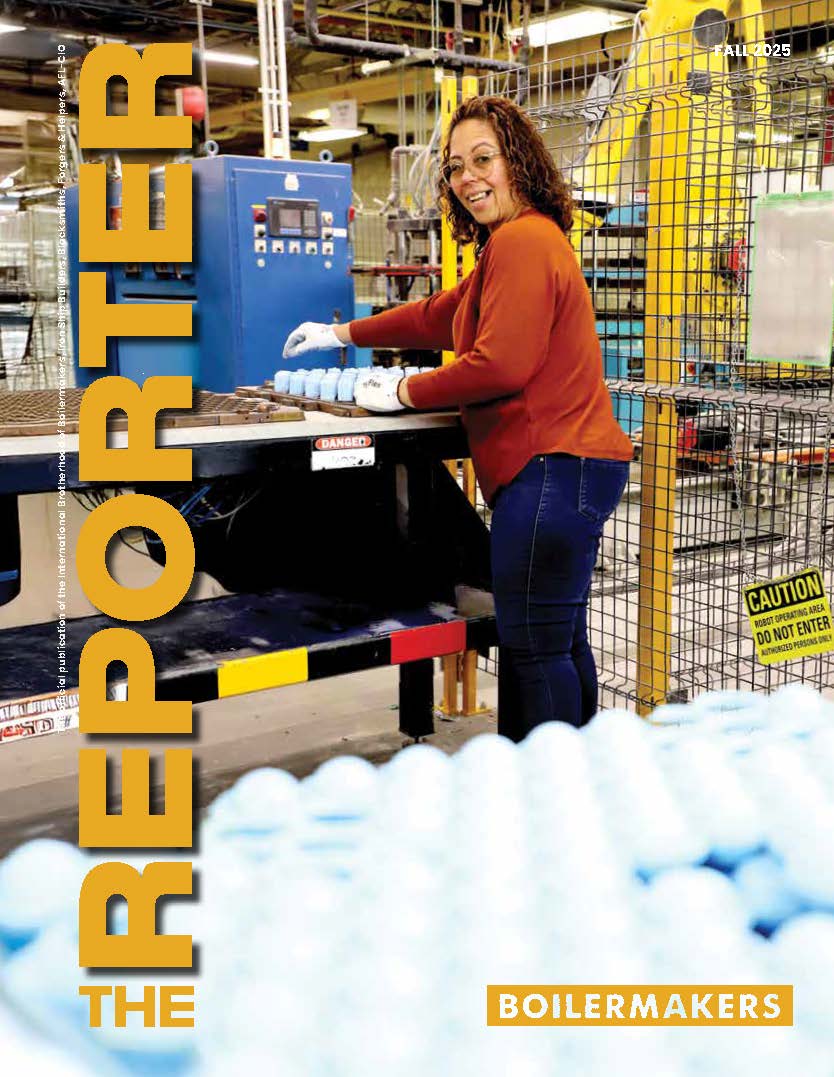Toronto Star writer recounts neighbor’s struggle with asbestos cancer
AMONGST HIS UNION brothers and sisters in Eastern Canada, Steve Silversides stood as a model of strength and dependability. No job seemed too big for the hearty, 54-year-old member of Local 128 (Toronto, Ontario), an avid hockey player and mountain biker. Silversides became a Boilermaker at age 19. During his career, he worked in construction, trained apprentices, represented union members, and looked after the health and safety of other Boilermakers.
But last September asbestos-related cancer took Silversides’ life. His unexpected death shocked family members and friends as well as his many acquaintances in the labor community. And it moved Debra Black, a reporter for the Toronto Star, to write about the dangers of asbestos.
Black had been a neighbor of Silversides. She is also a friend of his partner, Liliane Vidicek. Steve and Liliane had been high school sweethearts whose romance rekindled after a class reunion eight years ago. Black learned that Silversides had worked near exposed asbestos while a construction Boilermaker decades ago, before its dangers were widely known. Ironically, one of his later responsibilities with the union was to help members with their claims arising from asbestos diseases.
For Black, Silversides’ fate symbolized the legacy of asbestos, a mineral that is excellent for insulating, fireproofing, and soundproofing applications but, because it is carcinogenic, exacts a steep price in human misery. To raise public awareness, she wrote two companion articles, both published in the Sept. 20, 2008, issue of the Star, telling Silversides’ story and explaining how asbestos cancers are reaching epidemic levels. One of her stories focused on another L-128 Boilermaker, John Blue, a retiree who died in 2006 of asbestos cancer. Blue’s son, David, is an active L-128 member.
Boilermakers have long history with asbestos
EVERY DEATH FROM asbestos disease is a tragedy in its own right. Boilermakers work in many industries where asbestos has been used, among them shipbuilding, cement-making, power generation, refining, and various kinds of manufacturing.
Asbestos diseases may take decades to occur
Deaths could reach 10 million
THE CANCERS THAT killed Steve Silversides and John Blue reveal an awful truth about asbestos diseases. These illnesses frequently have a long latency period. From the time of exposure to the time that cancer develops may span 30-40 years, or even longer. This is particularly true of mesothelioma, a rare but deadly cancer of the protective lining around lungs and other organs.
Many workers who were exposed in the 1960s through the mid-1970s — when asbestos use was reportedly at its peak — are just now developing cancer.
In 2007, the World Health Organization (WHO), the global health arm of the United Nations, reported that about 125 million people worldwide are exposed to asbestos at the workplace. The report cited various sources that indicate at least 90,000 people die annually from asbestos-related lung cancer, mesothelioma, and asbestosis due to occupational exposure. And several thousand more deaths each year can be attributed to other types of asbestos-related diseases as well as non-occupational exposures.
“The asbestos cancer epidemic may take as many as 10 million lives before asbestos is banned worldwide and exposures are brought to an end,” predicted Joseph LaDou, with the University of California School of Medicine, San Francisco, writing for Environmental Health Perspectives in 2004.
Jason McInnis, the union’s National Director of Health and Safety for Canada, told Black that Boilermakers who worked around asbestos up until the early 1990s “have yet to pay the full price for historically poor management, absent controls, and inadequate training.”
Health and Safety Specialist Mark Garrett stressed that the dangers of exposure still exist. “This is especially true in the construction industry, where members may be working around old boilers and other equipment. I tell our members, if there’s a possibility that a material might be asbestos, always assume that it is, and take appropriate measures for your protection.
“Our members have a lot of good training available to them,” he said, “including the OSHA 10-hour course.”
Over the years, the Boilermakers union has helped lead the effort to protect workers from asbestos in the workplace. The Brotherhood continues to promote asbestos safety and to support legislation that will ensure adequate compensation for victims and their families.
Many asbestos-containing products have been banned in the United States and Canada. Mining and exporting asbestos is no longer allowed in the United States.
However, Canada remains the second largest exporter of asbestos in the world (after Russia), mining the product in Ontario and shipping the material primarily to developing countries.
“Steve [Silversides] wasn’t very happy about any of that,” Black wrote. “He wanted something to be done to protect other workers. He wanted his death to mean something. Hopefully it will.”
Members treasure Silversides’ memory
STEVE SILVERSIDES’ death does indeed mean something to those who knew him.
L-128 BM-ST Jim Watson called Silversides “iconic,” exemplifying the best characteristics in a Boilermaker and a person.
AIP Stan Petronski Jr. said, “Steve had a firm façade about him. He faced each and every challenge with a strong work ethic and a dedication to the causes at hand.”
Jim Tinney, Assist. Dir. for Construction Sector Operations in Canada and a close friend of Silversides, said, “His name is well known throughout Ontario and in the U.S. Wherever he worked, whatever role he took on — general foreman, business representative, health and welfare representative, QCC [Quality Control Council] manager, director of apprenticeship and training — Steve had a tremendous work ethic and a larger-than-life personality.”
Another close friend, L-128 Bus. Rep. Andy Holder, said, “Steve had a keen mind. We could put him in any position and he would rise to the occasion. His death is a great loss to Local 128 and to the Boilermakers union as a whole.”
Debra Black’s stories about Steve Silversides and John Blue remind us of the price workers and their families continue to pay for asbestos exposure in years past — and the continuing need to be vigilant when working near asbestos on the job even now.






